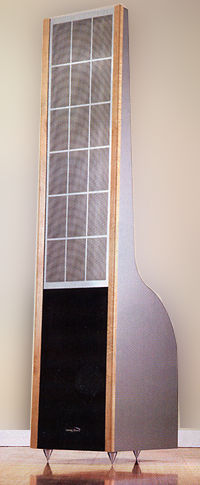| Columns Retired Columns & Blogs |
InnerSound Eros Mk.III electrostatic loudspeaker
I was trading e-mails with Roger Sanders, manufacturer of the Eros Mk.III electrostatic (ESL) loudspeakers, when it occurred to me to ask him about his name. I was struck that he had the same last name as Gayle Sanders, president of another American electrostatic speaker company, MartinLogan. Were they related? "No," replied Roger Sanders, "it's simply a coincidence that we have similar names. I've never even met him.
 "Do you want to hear an even more amazing coincidence?" he continued. "The president of Sound Lab (the other American maker of ESLs) is Roger West. My first name is Roger. My last name is Sanders, which matches MartinLogan's president's last name. It seems rather amazing that the presidents of all three American ESL companies should share names."
"Do you want to hear an even more amazing coincidence?" he continued. "The president of Sound Lab (the other American maker of ESLs) is Roger West. My first name is Roger. My last name is Sanders, which matches MartinLogan's president's last name. It seems rather amazing that the presidents of all three American ESL companies should share names."
The InnerSound Eros Mk.III
The names of the presidents of the other American electrostatic speaker companies might be one of the few things the InnerSound Eros Mk.III shares with its competition. Take its size and configuration. The Eros is 5' 8" tall, 15" wide, and 18" deep, which is 1" taller, 1" wider, and 10" shallower—and 58 lbs lighter and $2000 cheaper—than its nearest competitor, the MartinLogan Prodigy that I reviewed in July 2001. And unlike the Prodigy's curved radiating screen, the Eros Mk.III's electrostatic panel is flat.
InnerSound deliberately used a flat panel for their electrostatic screen, knowing that the lateral dispersion would be greatly narrowed, and the resulting sweet spot so narrow that only one person could listen. Sanders believes that a speaker that beams its signal rather than disperses it sounds best in the nearfield. (Nearfield listening also reduces the subjective effect of a dipole speaker's backwave.)
The Eros's flat, narrow electrostatic panel is subdivided by a fine metal grids that form the screen's stators. Between the stators, and separated from them by 1/16" spacers, a thin sheet of Mylar serves as a driver. The stators need to be acoustically transparent while being electrically conductive. They also need to be effectively insulated, as the amplifier's output is connected to them through a high-voltage step-up transformer, which increases the audio output to several thousand volts. This high voltage is "felt" by the static charge (hence electrostatic speaker) that is applied to the Eros's Mylar diaphragm by a tiny power supply in the speaker itself (which is why it has to be plugged into the wall). The diaphragm therefore vibrates in response to the audio signal, producing sound.
Because bare Mylar is a good electrical insulator, it's necessary to coat the diaphragm with a material that will conduct the electrical charge and allow it to flow evenly over the diaphragm's surface. The technology associated with these coatings is the key to eliminating the problem of arcing and speaker damage. This is a very difficult and challenging technical problem; manufacturers are secretive about their coatings. The Eros Mk.III uses a rugged, reliable coating that allows it to play at extremely loud levels without arcing. It is also calimed to make it immune to humidity, dust, insects, and dirt. The Eros screens are sold with a five-year warranty.
The cabinet's black lower section curves out behind the screens to form the 10" woofer's transmission-line cabinet. Two pairs of WBT binding posts, to permit biamping are located at the back of the bass module.
There is no passive crossover. A separate Crossover-Bass Amplifier module functions as a control center. The Eros owner uses his own amplifier for the screens, and can drive the woofers with either the InnerSound amplifier or an outboard amp. Frequency settings can be controlled from the crossover's front panel or by the system's remote control. These controls adjust the Eros Mk.III's response to the owner's taste and room acoustics. The overall Level control adjusts the output of the satellite amplifier that drives the electrostatic screens from 360Hz up. The Midrange control adjusts the overall gain of the bass amplifier, raising or lowering the bass/midrange level relative to the ESL screens. Changing the setting of the Midrange control lets the listener blend the woofer output with the ESL output level to get the proper "fullness" in the midrange. The Bass control adjusts the woofer amplifier's output below 100Hz by altering the slope of the frequency response, which pivots around a nominal 100Hz turnover point.
The Eros Mk.III's main power switch is on its rear panel, while a separate switch for the 600Wpc bass amplifier is on the front panel, along with blue LED readouts that show which output level—Level, Midrange, or Bass—is being adjusted by the system's remote.
Looking inside the Crossover-Bass Amplifier, I found top-quality, computer-grade printed circuit boards, excellent components, a minimum of point-to-point wiring, and traces of a spider web. The Eros's electrostatic screens have a very satisfactory fit'n'finish, despite some minor functional problems quickly remedied by a call to the manufacturer. These loudspeakers are quite rugged, and should operate reliably for years.
- Log in or register to post comments




































